Reports
North Korea’s ELWR: Finally Operational After a Long Delay
by David Albright, Sarah Burkhard, Victoria Cheng, and Spencer Faragasso
January 23, 2024
Recent satellite imagery of North Korea’s Yongbyon Nuclear Complex indicates that North Korea’s long-delayed nuclear reactor, commonly called the Experimental Light Water Reactor (ELWR), commenced operating several months ago and is regularly operating, although it could not be determined if it has reached its announced full power of 100 megawatts-thermal (MWth). Since early October 2023, significant amounts of water have consistently been discharged into the nearby river. The discharge point was constructed over ten years ago in 2013 and appears directly connected to the ELWR. As such, it is assessed to be a critical part of the ELWR’s secondary cooling system where frequent discharge of hot water indicates reactor operation. This is consistent with late-December statements by International Atomic Energy Agency (IAEA) Director General Rafael Grossi that the IAEA detected increased activity around the reactor and a strong outflow of warm water, indicative of the reactor reaching criticality. After multiple months of operation, questions arise, including whether the ELWR is producing plutonium for North Korea’s nuclear weapons, and if so, how much? A worst-case assessment is that the reactor, once fully operational, could make 20 kilograms of weapon-grade plutonium per year, enough for 5-10 nuclear weapons per year, where the upper bound assumes that the plutonium is combined with weapon-grade uranium to form composite core nuclear weapons.
Signs of ELWR and 5 MWe Operation
The ELWR cooling water discharge point is located downstream from the ELWR cooling water intake pumphouse, and about 85 meters downstream from the reservoir dam. Water discharge was first visible in available satellite imagery on October 4, 2023 (see Figure 1),1 and from October 10 has been consistently visible through to the most recent reviewed image dated January 18, 2024. As expected, the visible discharge is significantly wider than the visible cooling water discharge from the smaller 5MWe reactor.
Figure 1. A significant amount of water discharge from the ELWR was first visible publicly in early October 2023 commercial satellite imagery and has been visible regularly since.
While the water outflow is consistently visible, the amount of outflowing water does not appear to have been consistent in volume, with some dates showing water gushing out of the discharge point in a wide stream, and others showing a thinner stream, albeit still significant. The widest water stream was noted on December 10, 2023 (see Figure 2). Imagery from just ten days later on December 20, 2023, shows an outflow that is half as wide.
Figure 2. A December 10, 2023, image shows significant water outflow at the ELWR cooling water discharge point.
Further indications that the discharged water is hot is provided by images taken in the winter, specifically those with a partially frozen river and snow coverage, which show that the hot water is melting the ice around the discharge point. This is the case for both the ELWR and the well-known discharge point for the smaller 5MWe reactor, which is further upstream the river (see Figure 3). An additional indicator of reactor activities is snow melt on the flat roof of the turbine buildings, visible for both the ELWR and the 5MWe reactor in this December 26, 2023, image.
Figure 3. A winter scene of a portion of North Korea’s Yongbyon nuclear complex shows signs that the 5MWe reactor and ELWR are operating.
Construction of ELWR Secondary Cooling System and Testing
Construction of the discharge point and pipeline connecting it to the ELWR building can be traced back to 2013 and is visible on satellite imagery (see Figure 4). A March 28, 2013, image shows trenching that starts at the ELWR and progresses towards the discharge point. A May 15, 2013, image shows further trenching and excavation towards and at the discharge point. Notably, a June 9, 2013, image appears to show water outflow with noticeable erosion nearby that may indicate an initial cooling circulation test run of the system without reactor operation.
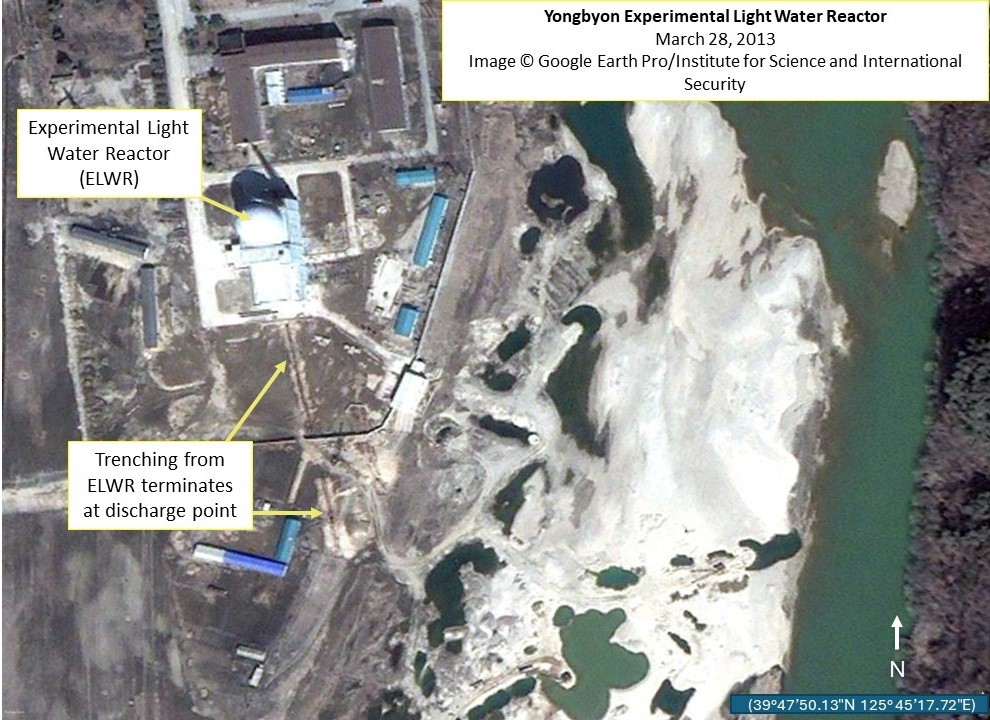
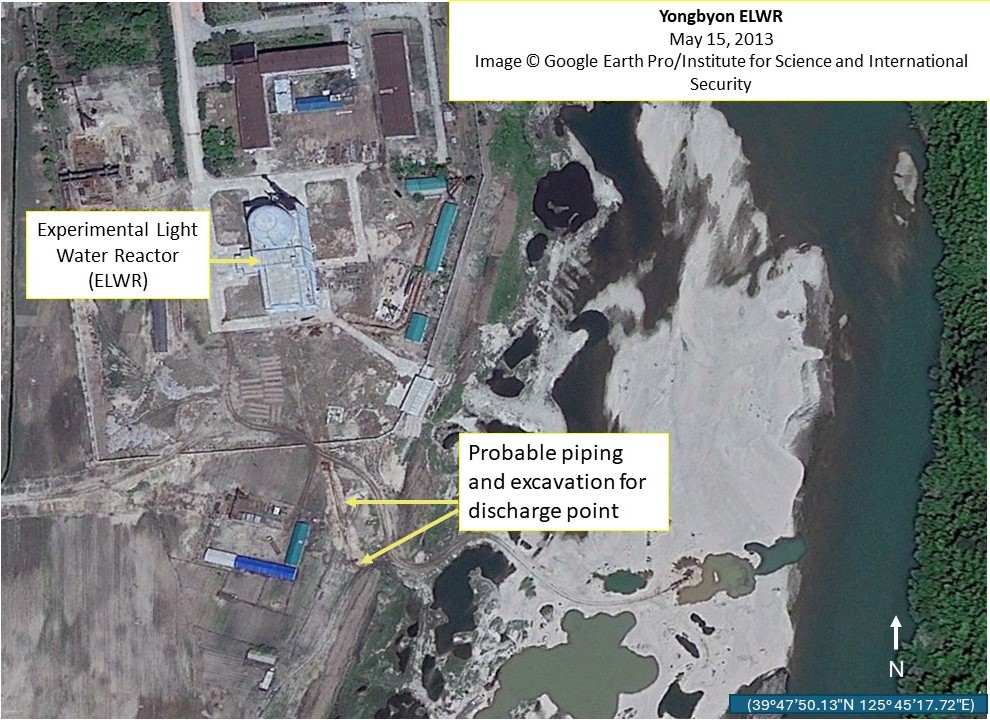
Figure 4. Trenching and excavation activities in 2013 show that the water discharge point is directly connected to the ELWR.
According to the 2022 annual IAEA safeguards report on North Korea, recent testing of the cooling water system could have taken place in July 2022.2 However, imagery reviewed dating to July 14, 22, 26, 28, and 30 did not show visible water discharge at the discharge point. The July 22, 2022, image appears to show some water outflow into the river from a discharge point nearby, but this discharge point is notably smaller and farther upstream than the current discharge point. The UN Panel of Experts on North Korea reports possible testing on February 27, 2023, March 7, 2023, and April 12, 2023, but also points to the smaller discharge point farther upstream in the associated images.3 Water outflow is still visible from this smaller discharge point on recent images, although its exact purpose cannot yet be established.
Levels of Operation and Plutonium Production
North Korean nuclear officials stated years ago that the nominal power of the ELWR would be 100 MWth, about five times more powerful than the adjacent reactor, commonly referred to as the 5 MWe reactor. However, this value has not been confirmed in the ensuing years as reactor construction delays mounted. Moreover, the water outflow can provide a relative measure of the operation of the reactor but cannot provide an absolute measure of the power output associated with a specific discharge.
In addition, the details of the reactor design have likewise not been verified. Typically, the reactor’s design is assumed to be based on a more traditional LWR of the type that was being built in North Korea by the Korean Peninsula Energy Development Organization (KEDO) in the 1990s and early 2000s. This type of reactor would have a heavy, thick pressure vessel, cooled and moderated by normal water, using enriched uranium oxide fuel. However, some European intelligence officials have indicated the existence of evidence that could point to a different reactor design, one with a larger reactor vessel, cooled by normal water but moderated by graphite. This design could use either natural or enriched uranium fuel.
Regardless of the type of reactor, it can produce weapon-grade plutonium. This is the case, as will be explained below, even if the reactor is a traditional LWR using enriched uranium oxide fuel.
Weapon-Grade Plutonium Production in an LWR4
In addition to electricity, an LWR will produce plutonium as a byproduct of its operation. In normal operation, such a reactor will produce reactor-grade plutonium, which, while not ideal, could be used directly in nuclear weapons. The use of reactor-grade plutonium in nuclear weapons would result in a lower explosive yield if it were substituted for weapon-grade plutonium in an existing warhead design. Over an extended period of storage, the warhead could also suffer from the extra heat generated by reactor-grade plutonium relative to weapon-grade plutonium. For North Korea, separating the plutonium from the irradiated fuel would require major modifications of the Radiochemical Laboratory. It was designed to process a different type of fuel, namely fuel from gas-graphite reactors, such as the 5 Mwe reactor. LWR irradiated fuel is much harder to process than gas-graphite spent fuel, requiring additional equipment and technology. Alternatively, North Korea could build a new plutonium processing plant designed to handle LWR fuel, although assessments of the existence or the construction of such a plant are ongoing.
However, weapon-grade plutonium can be produced in a LWR by using a non-traditional fuel/target design in the reactor core.5 In this case, the core would be composed of “driver” fuel and “target” elements. The driver fuel contains low-enriched uranium that produces neutrons which are absorbed by targets made from depleted or natural uranium to produce weapon-grade plutonium. The driver fuel would need to be enriched higher than typical for traditional LWRs, to 10-20 percent in the isotope uranium-235. The targets would be removed from the core and replaced with new targets when they contain an optimal amount of weapon-grade plutonium. They can be designed to ease their chemical processing to separate plutonium. The driver fuel would remain in the reactor until fully irradiated and replaced far less frequently than the targets.
The U.S. Department of Energy evaluated the use of a commercial-scale LWR reactor to make weapon-grade plutonium and tritium in a similar core in the late 1980s and early 1990s. The DOE considered the use of a commercial light water reactor that would have driver fuel enriched to 10 percent and two basic types of targets that would produce either weapon-grade plutonium or tritium. The driver fuel and targets should be within North Korea’s ability to design and make. The driver fuel would be similar to the type of fuel North Korea would be required to produce for a traditional LWR, albeit at a higher enrichment. Although the driver fuel would be challenging for North Korea to process and separate its plutonium, the targets should be far easier to design and chemically process. In any case, any irradiated LEU oxide fuel could be safely stored long-term in water.
If North Korea decided to use the LWR as a source of weapon-grade plutonium for weapons, it could grow its nuclear weapons arsenal significantly by using a driver fuel/target system. Several years ago, a worst-case estimate was conducted with the support of a reactor expert who was familiar with the use of driver fuel/target systems in reactors.6 The estimate assumes an optimal power of 100 MWth, a 70-80 percent capacity factor applied to year-round, full-power operation, a plutonium conversion of 0.85 grams of weapon-grade plutonium per megawatt-thermal-day, and an estimated 10 percent reduction in plutonium output to account for the plutonium produced in the driver fuel, which is not usable. The resulting estimate is 19.5-22.3 kg weapon-grade plutonium per year, rounded to 20 kg per year.
To assess enrichment requirements, the nuclear reactor expert said that a rule of thumb is that a core composed of 10-20 percent LEU driver fuel would have the same amount of uranium-235 as a core of 3.5 percent LEU fuel. North Korea has more than sufficient capacity to provide either 3.5 percent enriched uranium or 10 to 20 percent enriched uranium fuel for this reactor.
1. This discharge was noted by Jeffrey Lewis and David Schmerler. See “North Korea’s Experimental Light-Water Reactor (ELWR) is Possibly Operating,” December 21, 2023, https://www.armscontrolwonk.com/archive/1219037/north-koreas-elwr-now-appears-operating/. ↩
2. Report by the Director General, Application of Safeguards in the Democratic People’s Republic of Korea, GOV2022/40-GC(66)/16, September 7, 2022, https://www.iaea.org/sites/default/files/gc/gc66-16.pdf. ↩
3. UN Security Council, Report of the Panel of Experts established pursuant to resolution 1874 (2009), S/2023/656, September 12, 2023. ↩
4. This section is from David Albright, “North Korean Plutonium and Weapon-Grade Uranium Inventories,” Institute for Science and International Security, January 8, 2015 (revised October 7, 2015), https://isis-online.org/uploads/isis-reports/documents/North_Korean_Fissile_Material_Stocks_Jan_30_2015_revised_Oct_5_2015-Final.pdf. ↩
5. “North Korean Plutonium and Weapon-Grade Uranium Inventories.” ↩
6. “North Korean Plutonium and Weapon-Grade Uranium Inventories.” ↩

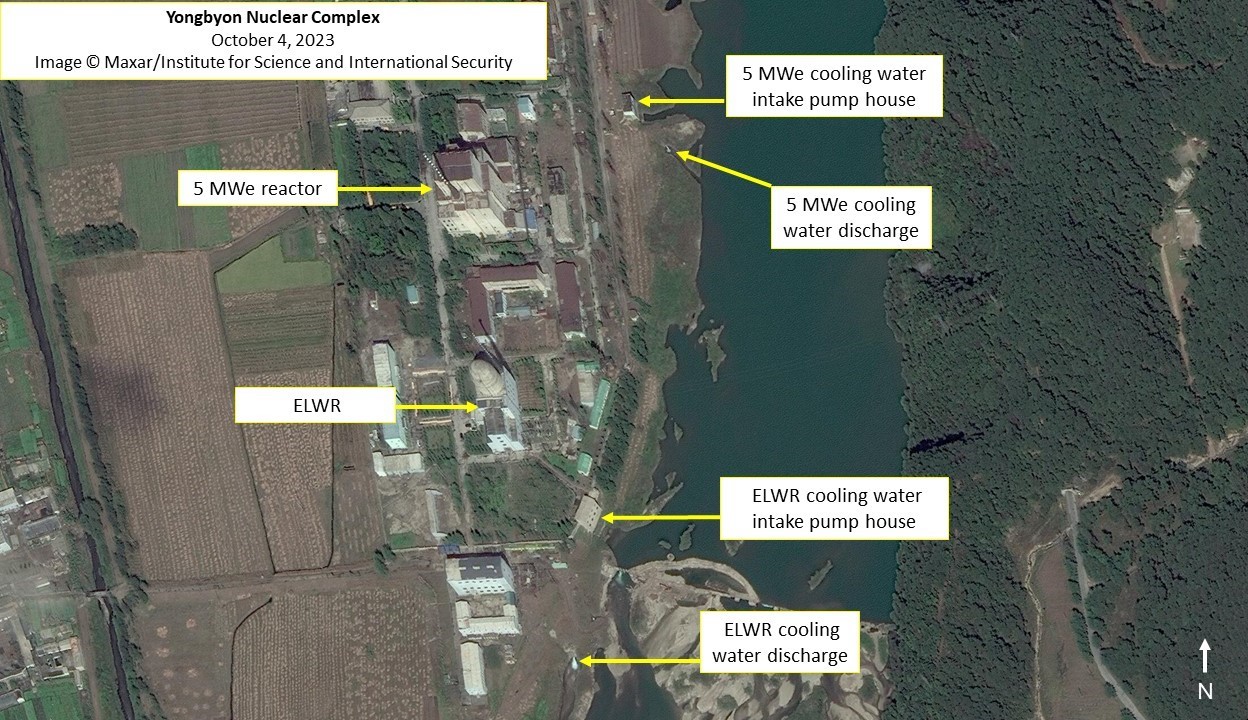
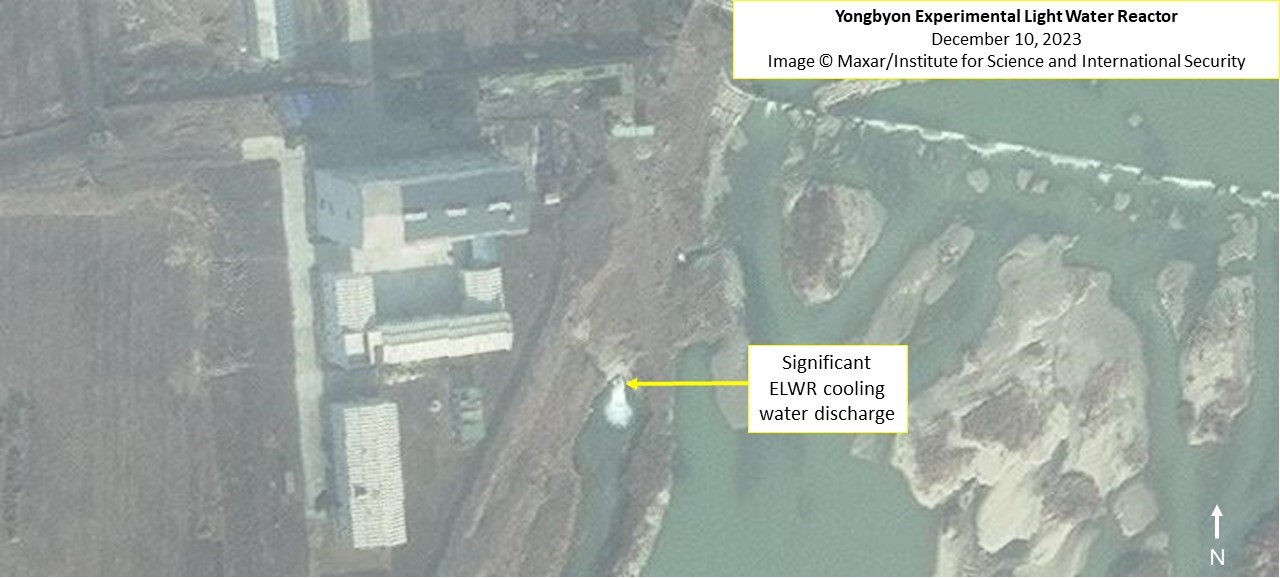
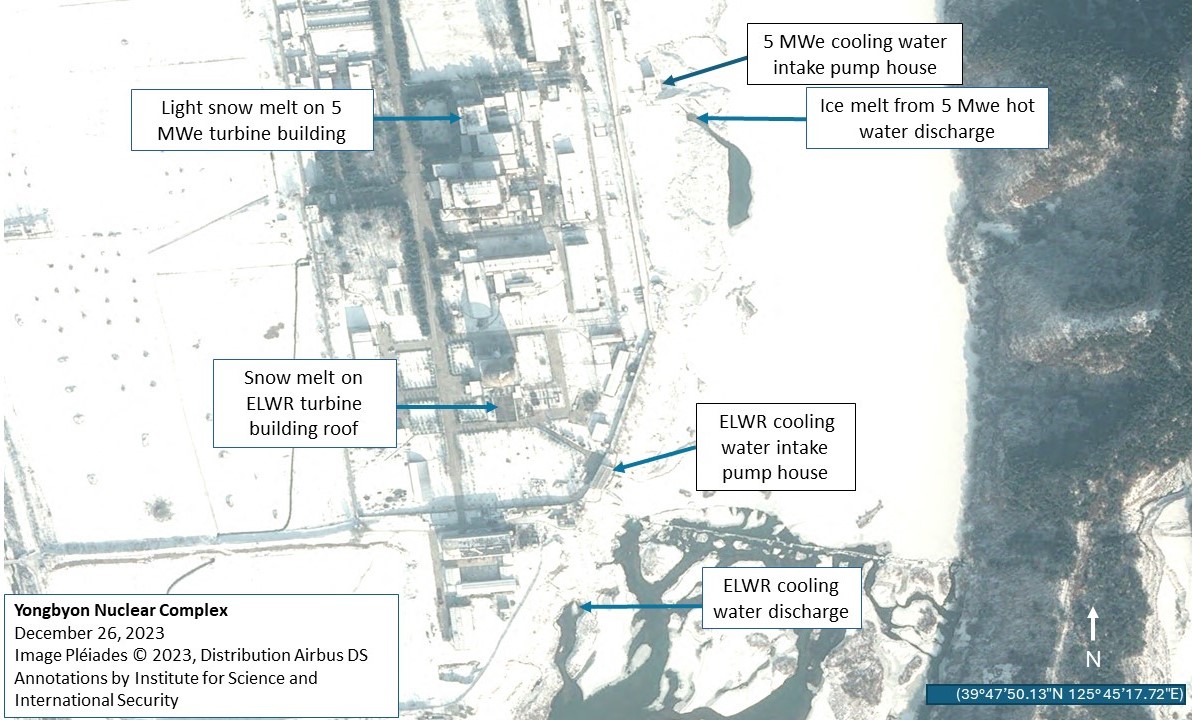
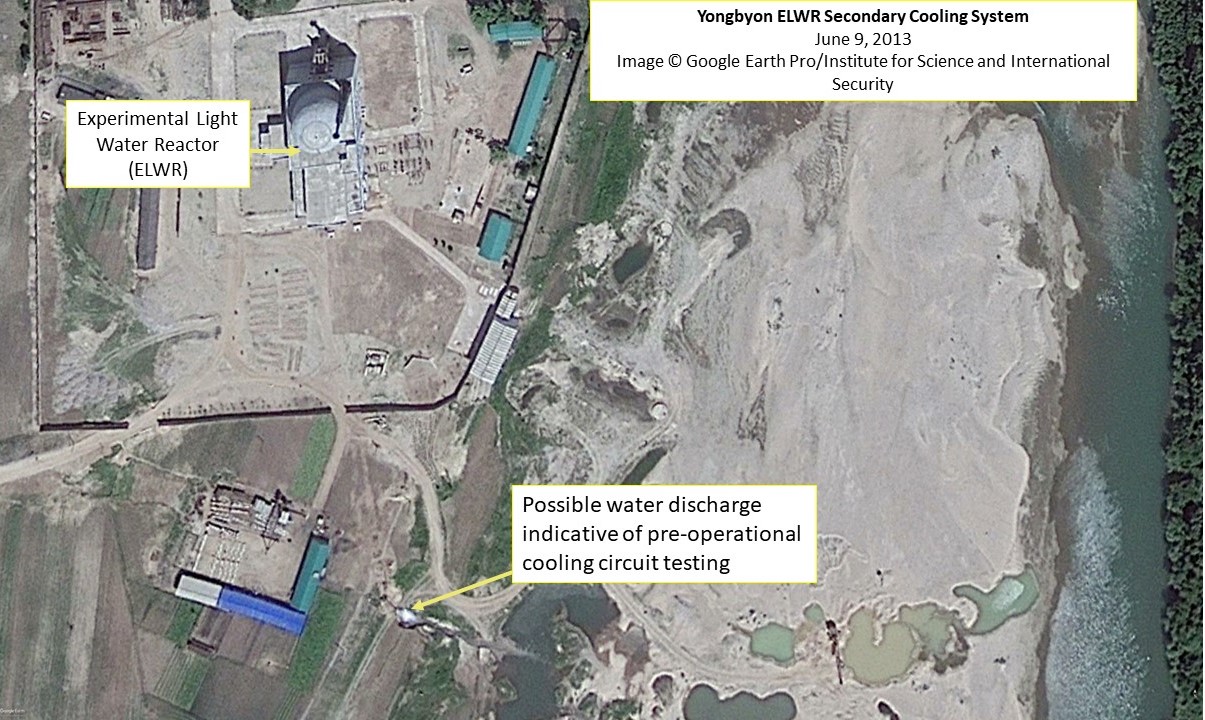
 twitter
twitter